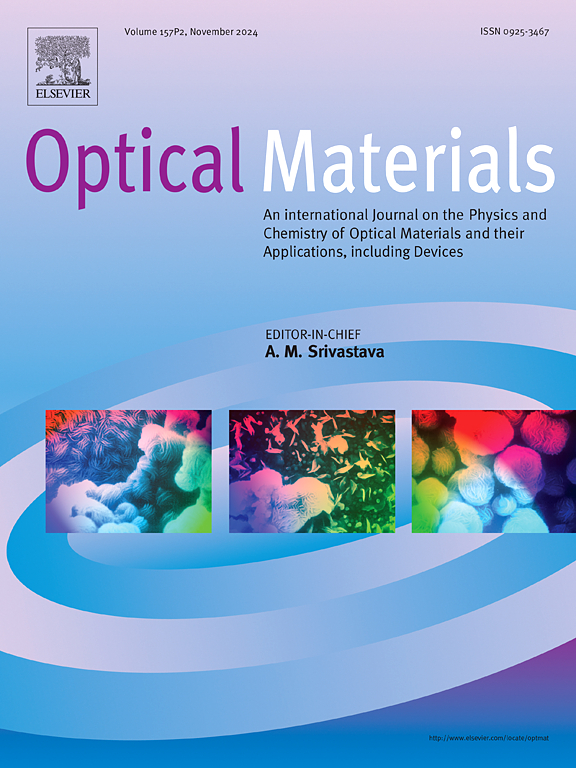Enhancing the optical properties of chitosan-based biopolymer for optoelectronic applications using natural dye extracted from hollyhock waste flowers
IF 3.8
3区 材料科学
Q2 MATERIALS SCIENCE, MULTIDISCIPLINARY
引用次数: 0
Abstract
The current study focuses on enhancing the optical characteristics of chitosan (CS) biopolymer by incorporating natural dyes extracted from hollyhock waste flowers (HWFs). CS was dissolved in a 1 % acetic acid solution, while pure distilled water was used to extract the natural dyes from HWFs. To avoid the film brittleness of the samples, a fixed amount of glycerol was added to each system. A solution cast procedure was applied to produce flexible dye-doped CS films. FTIR analysis of the HWFs dye reveals the presence of key functional groups, including OH/NH, C![]() O, C–O–C, and CH, which can effectively interact with the host biopolymer. The FTIR spectra of CS, Glycerol (Gly), and the CS:Gly:HWFs-dye show significant interactions between the polymer, plasticizer, and HWFs dye. The increase in the absorption behavior of CS was observed, along with a shift in the absorption edge towards lower photon energies, reaching 2.7 eV. Absorption enhancement is responsible for the decrease in transmittance. As the dye concentration increases, the optical dielectric constant and refractive index improve. Two main methods were used to study the optical band gaps of CS:Gly: HWFs-dye systems in detail. First, the band gap was determined by plotting the optical dielectric loss against photon energy. Second, the Tauc model was employed to identify band-to-band transitions, with potential direct and indirect transitions presented in separate graphs. The system's primary transition types were characterized by comparing optical dielectric loss charts with those derived from the Tauc model. After adding HWFs-dye natural dye, the band gap in the optical viewpoint of pure CS decreased from 5.27 to 2.50 eV. The Urbach energy (EU) for the films was determined and found to be higher in the doped samples than the pure film. The increase in EU values with higher HWF dye content in the CS suggests a corresponding rise in disorder and defects within the band structure of the composites. It can be inferred from this that the current technology holds great promise for optoelectronic devices.
O, C–O–C, and CH, which can effectively interact with the host biopolymer. The FTIR spectra of CS, Glycerol (Gly), and the CS:Gly:HWFs-dye show significant interactions between the polymer, plasticizer, and HWFs dye. The increase in the absorption behavior of CS was observed, along with a shift in the absorption edge towards lower photon energies, reaching 2.7 eV. Absorption enhancement is responsible for the decrease in transmittance. As the dye concentration increases, the optical dielectric constant and refractive index improve. Two main methods were used to study the optical band gaps of CS:Gly: HWFs-dye systems in detail. First, the band gap was determined by plotting the optical dielectric loss against photon energy. Second, the Tauc model was employed to identify band-to-band transitions, with potential direct and indirect transitions presented in separate graphs. The system's primary transition types were characterized by comparing optical dielectric loss charts with those derived from the Tauc model. After adding HWFs-dye natural dye, the band gap in the optical viewpoint of pure CS decreased from 5.27 to 2.50 eV. The Urbach energy (EU) for the films was determined and found to be higher in the doped samples than the pure film. The increase in EU values with higher HWF dye content in the CS suggests a corresponding rise in disorder and defects within the band structure of the composites. It can be inferred from this that the current technology holds great promise for optoelectronic devices.

求助全文
约1分钟内获得全文
求助全文
来源期刊

Optical Materials
工程技术-材料科学:综合
CiteScore
6.60
自引率
12.80%
发文量
1265
审稿时长
38 days
期刊介绍:
Optical Materials has an open access mirror journal Optical Materials: X, sharing the same aims and scope, editorial team, submission system and rigorous peer review.
The purpose of Optical Materials is to provide a means of communication and technology transfer between researchers who are interested in materials for potential device applications. The journal publishes original papers and review articles on the design, synthesis, characterisation and applications of optical materials.
OPTICAL MATERIALS focuses on:
• Optical Properties of Material Systems;
• The Materials Aspects of Optical Phenomena;
• The Materials Aspects of Devices and Applications.
Authors can submit separate research elements describing their data to Data in Brief and methods to Methods X.
 求助内容:
求助内容: 应助结果提醒方式:
应助结果提醒方式:


